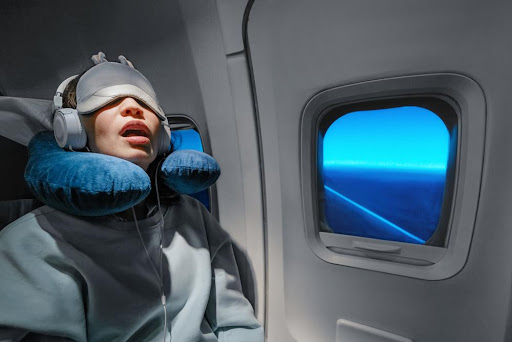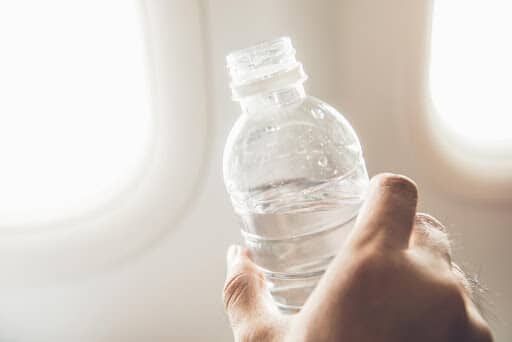Sleeping on a plane can feel like an uphill battle, but with the right strategies, you can turn your next flight into a restful retreat. Whether it’s a short hop or a long haul, getting quality rest during travel is crucial for maintaining your health and well-being. One tool making waves in the travel community is the weighted blanket that provides comfort and a sense of calm to restless travelers — but there are others, new and old, as well. Join us as we explore them, along with a diverse mix of tips, from the practical to the unexpected, designed to help you sleep soundly in the skies.
1) A Comfortable Hug with a Travel Weighted Blanket
A good night’s sleep while traveling often seems elusive, but it’s more attainable with the help of a travel weighted blanket. Grounded in deep touch pressure therapy, weighted blankets mimic the feeling of a comforting embrace, helping to reduce anxiety and promote better sleep. The right travel blanket depends on personal preference and weight. Generally, a weighted should weigh about 10 percent of the user’s body weight, but you might want to go lighter if weight restrictions are an issue or consideration. The material also matters as it affects breathability and warmth. Many travelers have experienced the soothing effects of these blankets, enhancing their in-flight slumber and overall travel experience.
2) Embrace Support with the Right Neck Pillow
We’re familiar with the struggle to find a comfortable sleeping position on a flight, and a neck pillow can be the perfect ally in this pursuit. Neck pillows, including weighted variants, provide crucial support, preventing discomfort and neck strain. A weighted neck pillow adds stability, grounding you in your seat for a more peaceful rest. Choosing the right neck pillow requires considering your comfort needs and sleep habits. Do you lean to one side, or do you prefer to sleep upright? Once the perfect pillow is found, using and maintaining it properly can prolong its usefulness and hygiene.
3) Never Be Blinded by the Light with the Ideal Sleep Mask
In the bustling environment of an airplane, a sleep mask can serve as your personal blackout curtain. Some travelers find additional comfort with a weighted sleep mask, which offers light pressure along with light-blocking capabilities. The benefits of using a sleep mask extend beyond mere darkness. Increased melatonin production and reduced jet lag are also perks of wearing one. When selecting the perfect sleep mask, consider the mask’s material for comfort and fit to ensure effective light blocking.

4) Slip into Sleep with Soothing Sounds
Airplanes aren’t the quietest environments, but using soothing sounds or white noise can be a game-changer for sleep seekers. Certain sounds — whether it’s the hum of white noise or gentle rain — can mask disruptive noises and trigger the brain’s relaxation response. Numerous apps and devices are available that offer a variety of soundscapes tailored to promote sleep. When using these, choosing comfortable headphones or earbuds — preferably noise-canceling — is essential for an optimal experience. Travelers who’ve incorporated soothing sounds into their flight routines may experience enhanced sleep quality, proving that the right sounds can indeed usher in peaceful slumber amidst the commotion.
5) Stay Hydrated and Snooze on
Hydration is often underestimated in its impact on sleep quality, especially during flights. Dry cabin air combined with diuretics like alcohol and caffeine can lead to dehydration, affecting sleep negatively. Opting for hydrating beverages — such as herbal tea or water — can counteract these effects and promote better sleep. It’s important to board your plane properly hydrated. This task starts 24 to 48 hours before embarking on your journey. Remember, frequent sips before feeling thirsty is the best way to prevent dehydration. Once on the plane, we suggest reducing fluid intake about an hour before planning to sleep to avoid waking up for bathroom trips. Travelers who make these hydration adjustments are more likely to experience improved sleep during flights, underlining the importance of mindful beverage choices in the quest for restful in-flight slumber.

6) Smart Seat Selection for Undisturbed Slumber
The path to in-flight sleep begins could begin with strategic seat selection. The window seat, for instance, provides a wall to lean against and fewer disturbances. In contrast, aisle seats may offer more legroom and easy bathroom access. Exit-row seats can offer extra space, but their ability to recline might be limited. Securing the best seat requires early booking, and frequent flyer status can sometimes provide more options. Additionally, staying away from high-traffic areas like the bathrooms or food prep stations will ensure less foot traffic and disturbances. Experienced travelers attest that the right seat has the potential to drastically enhance sleep quality, turning the often-dreaded plane sleep into a much more restful experience.
7) Practice Pre-Flight Yoga for Restful Relaxation
Turning to the ancient discipline of yoga might be your answer to restful sleep on a plane. Practicing specific yoga poses before a flight can help loosen tight muscles and prime the body for restful sleep. Poses such as forward bends, gentle twists and guided relaxation can be incorporated into pre-flight routines. The benefits of yoga extend beyond flexibility. It’s a potent stress reducer, which can be highly beneficial before boarding a flight. You’re one step closer to enhanced sleep quality by embracing a pre-flight yoga routine.
Ready for Rest: Sleeping Soundly on Your Next Flight
Sleeping on a plane doesn’t have to be a feat of endurance. With these tips in your travel toolkit, we’re confident you can transform the seemingly impossible into a comfortable reality. Whether it’s finding tranquility with a travel-weighted blanket or slipping into slumber with the soothing hum of white noise, these strategies offer diverse ways to promote restful sleep during your journey. We wholeheartedly encourage you to experiment with these tips, discovering a sleep routine that caters to your individual needs. Remember that prioritizing rest during travel is a commitment to your well-being. It’s not just about arriving at your destination but making the journey itself more enjoyable and restorative. So here’s to more tranquil skies and peaceful slumbers. Your next flight could very well be the most restful journey you’ve ever taken.